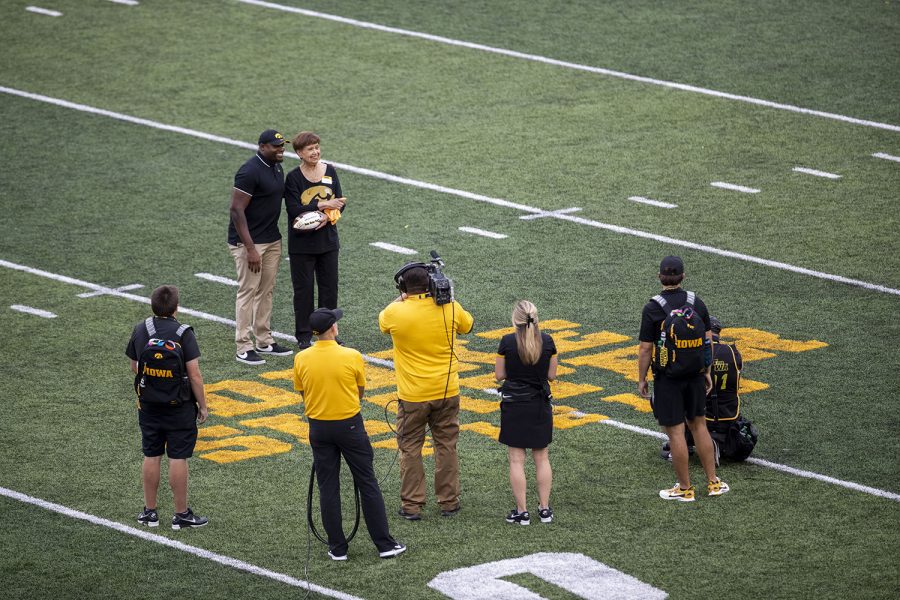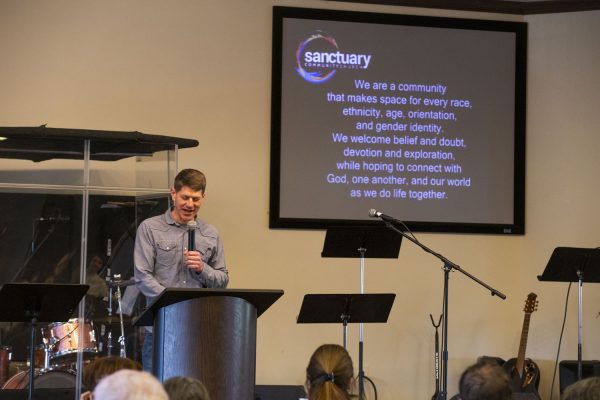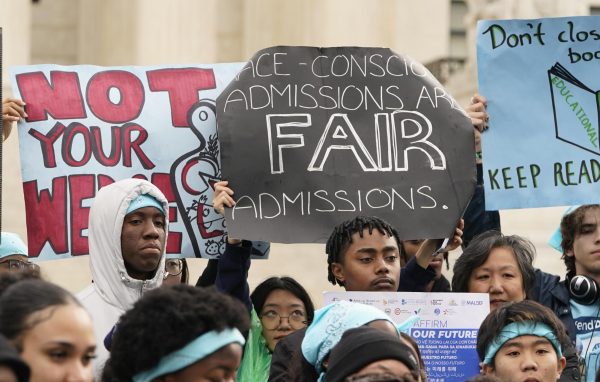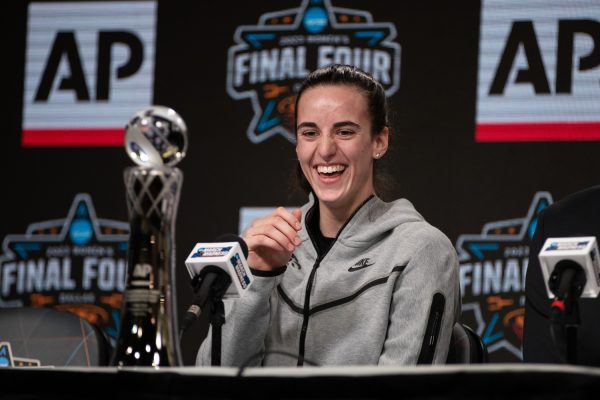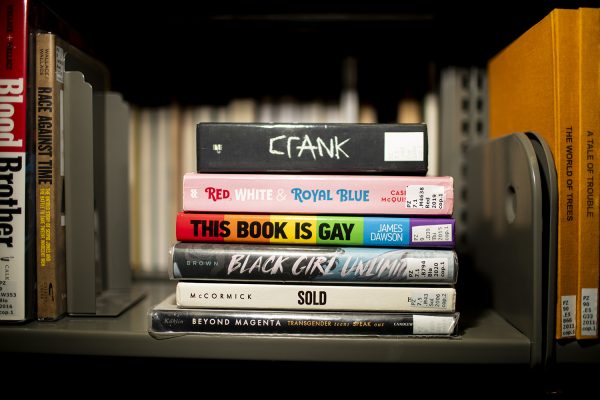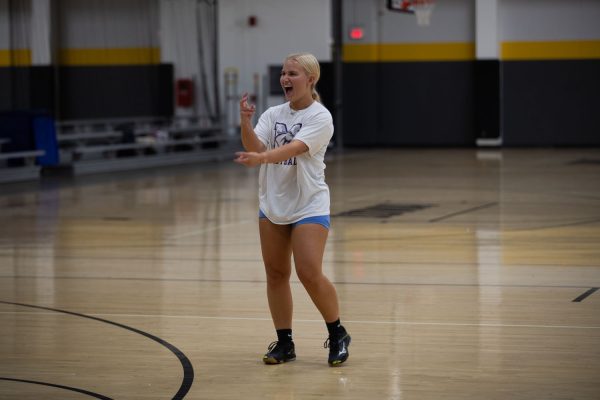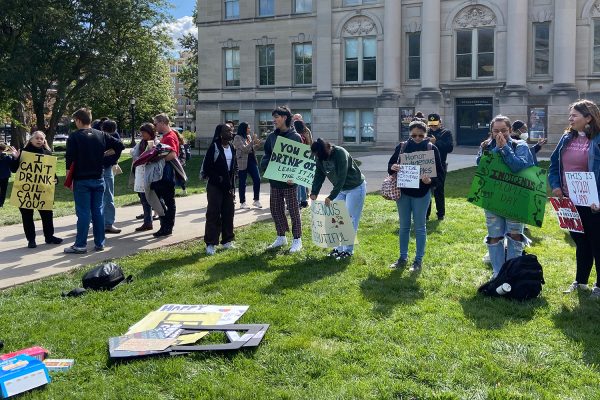Duke Slater Field: the reaction to recognizing a historic Iowa football player
The University of Iowa decided to name Kinnick Stadium’s field after Duke Slater, one of the first Black players in Iowa Athletics history, in July.
Niece of Duke Slater, Sandy Wilkens, accepts a football award for Duke Slater Field during a football game between No. 3 Iowa and No. 4 Penn State at Kinnick Stadium on Saturday, Oct. 9, 2021. The Hawkeyes defeated the Nittany Lions 23-20.
October 26, 2021
Cole Grolmus was perched in his grandfather Carroll Scott’s season ticket seats at Kinnick Stadium in section 108. He roared on his beloved Hawkeyes from the east stands as they faced Penn State during the stadium’s biggest game since 1985.
Grolmus made the decision to attend the Oct. 9 game a couple weeks beforehand — but the main reason he went was not because the game featured two AP top-5 teams.
Instead, Grolmus was there because the University of Iowa was honoring its historic 1921 Big Ten champion football team at halftime, which included the official dedication of Duke Slater Field — named after the legendary Black tackle on that squad.
For the first time, Grolmus, a 2007 UI graduate, observed the words “Duke Slater Field” painted in bold, golden letters at each 25-yard line.
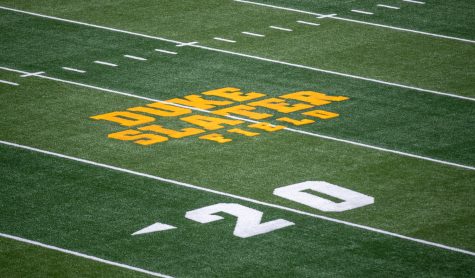
The dedication of the field to a historic Iowa athlete had special significance to Grolmus.
“Seeing it in person, it was incredible to see,” Grolmus said. “It’s just a completely different experience when you see it with your own eyes. In my case, I was fortunate enough to watch the game with my 83-year-old grandpa, who’s a 63-year season ticket holder, and it’s probably one of the best memories I’ll ever have.”
Many donning Black and Gold in the crowded stadium felt a sense of school pride as Sandra Wilkins, Duke Slater’s niece, stood on the field with Broderick Binns, the athletics department’s diversity, equity, and inclusion director.
Grolmus, a cybersecurity consultant living in Minnesota, published a Twitter thread in June 2020 amid cries of racism and racial disparities within the Iowa football program from current and former football players.
He detailed the history of the naming of Kinnick Stadium. In 1972, there was a push from then-UI President Willard “Sandy” Boyd to name the venue Kinnick-Slater Stadium. The proposal was shot down after the campus planning committee told Boyd it didn’t want to use a hyphenated name, Boyd told The Daily Iowan last year.
Kinnick Stadium is one of our greatest treasures. It is also one of the greatest tragedies in our journey towards racial equality and social justice.
Kinnick Stadium was supposed to be named Kinnick-Slater Stadium.
— Cole Grolmus (@colegrolmus) June 7, 2020
The legend of Duke Slater
The first Black All-American football player at Iowa, Slater competed for the Hawkeyes from 1918-21.
Slater was not allowed to live on campus because of his race, but he still earned All-America honors twice.
After his college career, Slater played in the NFL from 1922-31 as the league’s first Black lineman. He garnered seven All-Pro honors and was inducted into the Pro Football Hall of Fame in August as part of its Centennial Class.
“He’s a pioneer,” Iowa defensive line coach Kelvin Bell said during Iowa Football Media Day in August. “You talk about a man of color who was able to do the things he did here at the university. He’s a real trailblazer for us.”
Slater returned to the UI while still in the NFL to earn a law degree in 1928. He became the first Black judge on the Cook County Superior Court in Chicago.
The road to the official naming: Kinnick-Slater Stadium: A not-so-new name proposal
Wilkins, an 82-year-old former school administrator now living in Fayetteville, Georgia, described her uncle as a proud, calm, and supportive person. Though Wilkins grew up in Los Angeles, Slater visited her every year during her childhood.
While she was a teenager, Wilkins went into an elevator with her uncle in Chicago. They witnessed the elevator operator shuffling around and speaking in a Southern dialect — at first causing Wilkins to criticize the operator’s behavior to her uncle.
Slater took Wilkins back into the elevator, where the man said, “How do you do, Judge Slater?” in what Wilkins recalled as a very distinguished voice.
“They talked, and then we got out of the elevator, and he said, ‘What did you learn from this?’” Wilkins told the DI. “I said, ‘Never judge people from their first appearance.’ Then, Uncle Duke explained to me that this man, who was doing all that what I call, ‘Shucking and jiving,’ because they gave him big tips and was putting two kids through college.”
When Wilkins stepped onto Duke Slater Field on Oct. 9, she said she was overwhelmed with the amount of school spirit she saw. Wilkins was also impressed with the relief statue depicting Slater outside of the stadium, because it showed him working with the Hawkeyes.

Slater would frequently go back to Iowa to support his Hawkeyes even after he was long gone from the UI and living 200 miles away — despite the unfair treatment he received while attending the institution.
“I don’t think he saw it as a segregated school,” Wilkins said. “When he met many of his friends over the years, when he would come to L.A. for football games or to be with us for Christmas, his friends were from all different aspects of life and all different races, so I never perceived Iowa as a racist school, but then when I looked at the history, it was like most schools during that time.
“It did have some racism, but he didn’t make that a big issue in his life,” Wilkins added. “He got to know the people that he worked with, that he played with that he knew, and I think that’s why he was so accepted by everybody.”
The naming
The talk around honoring Slater on the field settled down after summer 2020.
But on July 21, Grolmus received a direct message on Twitter from AP correspondent Ryan Foley.
Foley was about to report that the UI was planning to rename the field after Duke Slater, pending Board of Regents approval.
One week later, the state Board of Regents unanimously approved the recommendation from the UI. Two days after the approval, crews began installing the gold emblem against the green turf.
“Back when we did the renovation of that north end zone, we added that relief statue of Duke,” Matt Henderson, UI deputy director of athletics for external relations, said. “And, over time, our athletic director, Gary Barta, continued to learn more about Duke Slater’s story. We just felt that putting Duke’s name on the field would be a great capstone to Duke’s history and accomplishments.”
An economist for the Bureau of Labor and Statistics, and a 2002 UI graduate, Neal Rozendaal was elated to hear from news reports that the Kinnick Stadium field was going to be named after Slater. He wrote the book, Duke Slater: Pioneering Black NFL Player and Judge, which Grolmus cited in his Twitter thread.
Rozendaal immediately phoned Wilkins to celebrate the tribute when he heard the news, he said.
“It’s one of those honors that is going to increase his visibility among not just Hawkeye fans, but really college football fans overall,” Rozendaal said. “That when they watch a Hawkeye football game, they’ll be able to see Duke Slater’s name on the field, and it will prompt them to learn more about him and his remarkable story.”
Iowa senior running back Ivory Kelly-Martin highlighted the significance of Slater’s name on the Kinnick Stadium turf — not just to the Black community, but to everyone associated with the UI.
Timeline by Chris Werner/The Daily Iowan
“This means a lot to me, and it means a lot to all Hawkeyes,” Kelly-Martin said at the Iowa Football Media Day in August. “Not just people of my race, but everybody. It’s nice that people like this are being celebrated, being supported, and given a stage. It gives you a better understanding of the things he had to go through back then.”
When Wilkins attended UCLA in the late 50s and early 60s, she talked a lot with her uncle about racism and the civil-rights movement.
“If it’s based in truth and love, it will become a fruition and happen,” Wilkins said Slater repeatedly told her.
Slater knew the words of the U.S. Constitution could guide the country to a more equal place, but Wilkins thought Slater was crazy for thinking about that.
Slater died in 1966, shortly after the passage of the 1964 Civil Rights Act. The pioneering athlete wasn’t around to see the 1969 boycott by Iowa football players over unfair treatment, or the recent cultural shift and racial reconciliation the program went in summer 2020.
So, what would have Slater thought of the ways the UI has honored him since his death?
“I never saw him brag or anything, but I think I saw him when he felt pride and joy in things the family had done or something had happened, that he was really appreciative of in Chicago,” Wilkins said. “And I think that’s probably how he would have felt, seeing the integrated football team. He lived during such a different time for Black folks that I think he would have been very pleased. He saw a lot of progress and received a lot of recognition, but I think he would have been very, very impressed with what he’s been acknowledged, and I sort of believe that he knows.”



